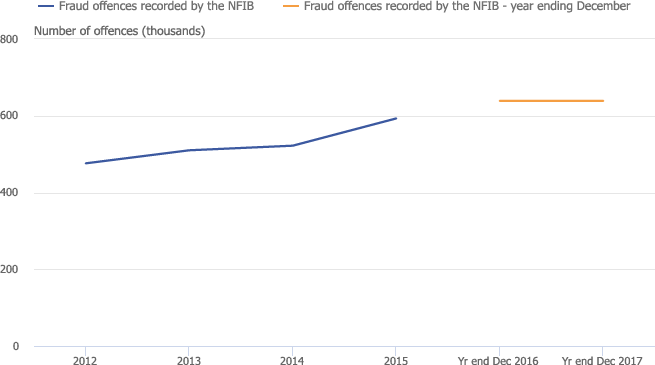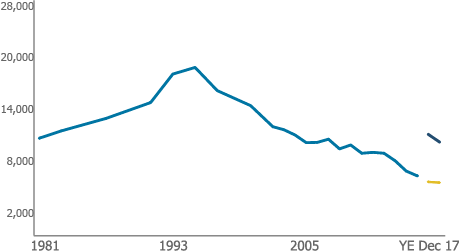Fraud in England and Wales: year ending December 2017
Attempted fraud and fraud offences involving a loss. Including cyber crime, computer misuse, false accounting, and banking and credit industry fraud.
Released date: 26 April 2018
Next release: 19 July 2018 (provisional)
This is part of the latest release | View previous releases
No change in the volume of fraud offences in the last year
England and Wales, year ending March 2012 to year ending December 2017

Source: Action Fraud, National Fraud Intelligence Bureau (NFIB)
Over half of fraud incidents were cyber-related.
The National Fraud Intelligence Bureau (NFIB) recorded a similar number of fraud offences: 639,457 offences, 19 fewer offences than the previous year.
Sections
Summary
No increase in the amount of fraud
3.2 million fraud offences were measured by the Crime Survey for England and Wales (CSEW). This has not increased from the results of last year’s survey.
The number of incidents referred to the National Fraud Intelligence Bureau (NFIB) was also unchanged. The recorded crime series incorporates fraud offences collated by the NFIB from Action Fraud, Cifas, UK Finance and incidents referred to the police for investigation. This series recorded a similar volume of fraud offences recorded in England and Wales in the year ending December 2017 (639,457 offences) compared with the previous year (639,476 offences).
read more
Drop in offences such as investment fraud or charity fraud
The only category of fraud to show a significant change was “other fraud” (down 64%, from 97,000 to 35,000 offences).
- Statistically significant change at the 5% level is indicated by an asterisk.
- Non-investment fraud has been renamed as 'Consumer and retail fraud' to reflect the corresponding name change to the Home Office Counting Rules from April 2017.
Small fall in banking and credit industry fraud, cheque, card and online bank account fraud
Although there was no overall change, differences were shown in the number of offences recorded in the last year.
Overall offences showed:
- Cifas fell by 7% (down to 283,284 offences)
- UK Finance fell by 6% (down to 82,575 offences)
The falls reported by both Cifas and UK Finance were due largely to a volume decrease in “banking and credit industry fraud", with UK Finance showing a fall of 6% (to 82,575 offences), and Cifas showing a fall of 5% (to 244,968 offences).
This latest decrease reported by Cifas follows a period of increases seen in this type of fraud, and is driven largely by a decrease in “cheque, plastic card and online bank accounts fraud” (down 5% to 169,504 offences).
Cifas also reported a 3% decrease in the latest year in the number of incidents of “application fraud” referred to NFIB. This includes opening up an account using fake or stolen documents in someone else’s name.
Again, this latest decrease in application fraud reported by Cifas follows previous large rises and is thought to reflect a return to normal levels after a spike in reporting in September 2016, as well as banks taking more preventative measures, in turn resulting in fewer fraudulent applications getting through the screening process.
Rate of fraud in Southern England slightly higher than in Wales or northern England
The latest police force area data show there was generally less variation in rates of fraud by police force area than for most other types of crime, although rates for force areas in southern England were generally a little higher than those among force areas in Wales or northern England.
Data
This bulletin mainly reports on data from two sources of crime data: the Crime Survey for England and Wales (CSEW) and police recorded crime.
More information on both these sources can be found in the User guide to crime statistics for England and Wales.
More about the data used in this bulletin
Fraud data is provided by Action Fraud – the public-facing national fraud and cybercrime reporting centre, as well as two industry bodies, Cifas and UK Finance, who report instances of fraud where their member organisations have been a victim.
Further information on each of the Fraud data sources and the differences between them can be found in Section 5.4 of the User guide fand also in the Overview of fraud and computer misuse statistics article.
Need to know
In this release
Crime in England and Wales
Over the long-term, crime has fallen, but some crimes have risen slightly in the previous 12 months

What you need to know
Data on this chart refer to different time periods.
1981 to 1999 refer to crimes experienced in the calendar year (January to December); and from year ending March 2002 onwards the estimates relate to crimes experienced in the 12 months before interview, based on interviews carried out in that financial year (April to March).
Violence crime in England and Wales
Little change in levels of violent crime in recent years

What you need to know
Police recorded crime data are not designated as National Statistics.
Weapons crime in England and Wales
Police recorded 7,130 (22%) more crimes involving weapons, with knife crime in cities rising most

What you need to know
Police recorded crime data are not designated as National Statistics.
Contact
Mark Bangs
crimestatistics@ons.gov.uk
+44 (0)2075 928689

